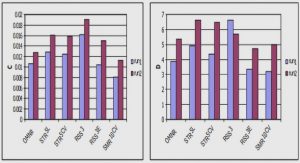Get Complete Project Material File(s) Now! »
Changing Overlapping Systems of Violence
From the examination of the failed successive peace-making efforts, one major problem is the fact that Issa-Afar violence is embedded in overlapping systems of violence discussed in chapter five. So, one of the imperatives for transforming Issa- Afar relations must be that it be ddone tandem with efforts of changing these systems of violence or delinking the local system of violence from the regional, national and subnational. However, delinking appears challenging as the relationship between the local and the other systems of violence are inextricably entwined.
Transforming the System of Violence in the Afar-Horn Sub-Region
The Afar Horn sub-region constitutes a system of violence because of the presence of unresolved issues of border conflict among the three Afar Horn states: Djibouti, Eritrea and Ethiopia.
the borders between Ethiopia and Eritrea, and Eritrea and Djibouti are flashpoints of violence requiring comprehensive transformation at the regional level. The inter-state tension among the the Afar-Horn states has a direct influence on the dynamics of Issa-Afar violence in Ethiopia.
Transforming the Ethiopian Federal System
Alluding to the national system of violence in Ethiopia does not mean that the entirety of the state system is immersed in violence. But the idea is to show that aspects of the state system affecting various dimensions of life in the country play into the creation and perpetuation of violence. It is meant to show how the national system of violence framing and contributing.
Transforming the Ethiopian Federal System
Alluding to the national system of violence in Ethiopia does not mean that the entirety of the state system is immersed in violence. But the idea is to show that aspects of the state system affecting various dimensions of life in the country play into the creation and perpetuation of violence.
Transforming the Afar and Somali Regions
Constructive transformation of Afar and Somali regions first requires addressing the sub-system of inter-ethnic violence in the lower Awash Valley. This area is a vestibula of Somali-Afar, Somali-Oromo, Afar-Oromo, Afar-Amhara, and Oromo-Amhara ethnic armed conflicts.
Transforming the Trauma of Inherited Violence
One of the recurring leitmotivs in the story of Issa-Afar peace-making is the unsettling effect of memory of past violence stored as communal trauma. As it is detailed in chapter three, the memories of tragic events of loss, eviction and victimization have become the framework of analyzing current events and envisioning the future. Bluntly put, memory of violence has become a cognitive framework capable of commanding behavior towards violence.
Chapter One
Introduction
1.1 On the Research Theme
1.2StudyObjectives
1.3LiteratureReview
1.4 The Research Problem
1.5 Research Methodology
1.6 Structure of The Thesis
1.7 Conclusion
Chapter Two
The Conceptual Framework of the Constructive Transformation of Violence
2.1 Introduction
2.2 The Obscurity of Violence
2.3 Defining Violence and Peace
2.4 Types of Violence and Peace
2.5 The Dynamics of Violence
2.6 Transforming/Transcending Violent Relations
2.7 Conclusion
Chapter three
Narratives of Old Issa-Afar Wars: the Organization and Nature of Violence in the pre-1991 Period
3.1 Introduction
3.2 Introducing the Issa and the Afar Societies
3.3 Historical Prognosis of Issa-Afar Violence
3.4 Nature, Organization and Purpose of Issa-Afar Violence
3.5 The Narratives of Old Issa-Afar Wars
3.6 Summary of the pre-1991 Issa Afar Violence
Chapter Four
The Overlapping Contexts of the Issa-Afar Violence in the post-1991 Period
4.1 Introduction
4.2 The Regional Context
4.3 The National Context
4.4 The Local Contexts of Afar and Issa
4.5 Overlapping Systems of Violence
The above overlapping contexts constitute a separate but interconnected source of violence, which contribute to the continuation of violence and failure of peace-making processes discussed in thesubsequent sections
4.6 Conclusion
Chapter Five
The Changing Face of Issa-Afar Violence: Organization, Meaning and Utility in the post-1991 Period
5.1 Introduction
5.2 The Organization of the new Issa-Afar Violence
5.3 The Meaning and Purpose of the New Issa-Afar Violence
5.4 The Dynamics of Issa-Afar Violence
5.5 Conclusion
Chapter Six
Issa-Afar Peace-Making and the Recurrence of Violence
6.1 Introduction
6.2 Issa-Afar Customary Peace-making
6.3 Nature, Organization and Process of Issa-Afar Peace-making during EEBW
6.4 Structures and Process of Peace-making
6.5 The Outcome of Issa-Afar Peace-making during the EEBW period
6.6 Post-EEBW Issa-Afar Peace-making
6.7 Issa-Afar Peace-Making and the Dynamics of the Violence
6.8 Conclusion
Chapter Seven
Changing the Structures of Violence and the Future of Issa-Afar Peace
7.1 Introduction
7.2 Changing Overlapping Systems of Violence
7.3 Transforming the Trauma of Inherited Violence
7.4 A Bottom-up Approach to Issa-Afar Peace-Making
7.5 A Comprehensive Approach to Issa-Afar Peace-Building
7.6 Conclusion
Chapter Eight
Theoretical Reflection on Recurrent of Violence and Peace-Making
8.1 Introduction
8.2 Recurrence of Issa-Afar Violence Explained
8.3 Reflection on the Recurrence of Violence
Bibliography





